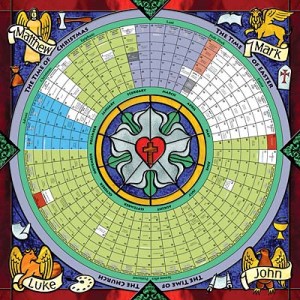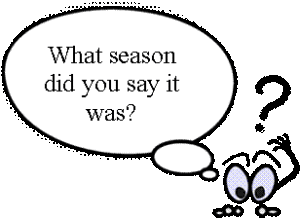The Lord be with you
Many denominations officially use the Church Year and all denominations use the Church Year to one degree or another. If you are part of a congregation that does not officially use the Church Year, but still celebrate days like Christmas and Easter, then you are unofficially using the Church Year. Those of us who officially use the Church Year use some terms that are well understood between denominations and other terms that are not as well understood across denominations. With this post I am hoping to provide some clarity concerning a few of these terms.
The first term is “Church Year.” Synonyms are the “Liturgical Calendar/Year” and the “Christian Calendar/Year.” This way of reckoning time is based on both the solar and lunar calendar. Those dates on it that are set by the solar calendar, like Christmas, are fixed to a specific date on the civil calendar (which is a solar calendar). So Christmas is always December 25. Those dates that are determined by the lunar calendar, like Easter, move each year as compared to the civil calendar. Easter can fall anytime from March 22 to April 25, inclusive.
 The Church Year is divided into two major parts. The first part is the festival half of the Church Year and the second is the non-festival part of the Church Year. They are called this because most of the the feasts and festivals of the Church year fall in the festival half of the Church Year. The non-festival half of the Church Year is called “ordinary time” in some denominations. The festival half of the Liturgical Calendar has ALL of the major feasts and festivals that are associated with the life and ministry of Jesus. The year is further divided into “times.” There are three “times:” The Time of Christmas; The Time of Easter; and The Time of the Church. These “times” are further divided into “seasons.” Different denominations have more or fewer seasons. Seasons, then, are the first place where you will discover significant differences between liturgical churches. Even within a specific denomination you will discover that seasons change over time. For example, when we used The Lutheran Hymnal (TLH), the season following Trinity Sunday was called the Trinity season. Today, using Lutheran Service Book (LSB), it is called the Pentecost season (though some of our churches hold o
The Church Year is divided into two major parts. The first part is the festival half of the Church Year and the second is the non-festival part of the Church Year. They are called this because most of the the feasts and festivals of the Church year fall in the festival half of the Church Year. The non-festival half of the Church Year is called “ordinary time” in some denominations. The festival half of the Liturgical Calendar has ALL of the major feasts and festivals that are associated with the life and ministry of Jesus. The year is further divided into “times.” There are three “times:” The Time of Christmas; The Time of Easter; and The Time of the Church. These “times” are further divided into “seasons.” Different denominations have more or fewer seasons. Seasons, then, are the first place where you will discover significant differences between liturgical churches. Even within a specific denomination you will discover that seasons change over time. For example, when we used The Lutheran Hymnal (TLH), the season following Trinity Sunday was called the Trinity season. Today, using Lutheran Service Book (LSB), it is called the Pentecost season (though some of our churches hold o nto the name “Trinity season”). Also, with TLH, the last three Sundays of the Church year were called “The Third-Last Sunday of the Church Year;” “The Second-Last Sunday of the Church Year;” and “The Last Sunday of the Church Year.” These three Sundays were kind of a mini-season that focused on Second Coming themes. With LSB this mini-season has disappeared. In the Roman Catholic Church the Holy Triduum is considered a season, while most (all?) Protestant denominations do not separate them out of Holy Week or the season of Lent in general.
nto the name “Trinity season”). Also, with TLH, the last three Sundays of the Church year were called “The Third-Last Sunday of the Church Year;” “The Second-Last Sunday of the Church Year;” and “The Last Sunday of the Church Year.” These three Sundays were kind of a mini-season that focused on Second Coming themes. With LSB this mini-season has disappeared. In the Roman Catholic Church the Holy Triduum is considered a season, while most (all?) Protestant denominations do not separate them out of Holy Week or the season of Lent in general.
In the LC-MS, then, our Liturgical Year breaks down as follows:
Festival Half
The Time of Christmas
Advent Season
Christmas Season
Epiphany Season
The Time of Easter
Lenten Season
(This season begins with Ash Wednesday for most of our congregations but a significant minority begins it with a three Sunday “Pre-Lent Season.” For all, it continues through Holy Saturday of Holy Week.)
Holy Week (which isn’t really considered a season but as part of Lent)
Easter Season
(This ends with Pentecost Sunday)
Non-Festival Half
The Time of the Church
The Season after Pentecost
(The Season after Pentecost begins with the Festival of the Holy Trinity and ends with the Last-Sunday of the Church Year)
In an earlier post, I made comments concerning “feasts,” “festivals” and “commemorations.” If you are interested in reading that post, just follow this link:
Blessings in Christ,
Pastor Rickert
